Ariston C 3V7 M.3, C 3V7 M.3 W R User Manual

Important safety warnings
To maintain the EFFICIENCY and SAFETY of this appliance, we recommend:
•call only the Service Centers authorized by the manufacturer
•always use original Spare Parts
1This appliance is intended for nonprofessional use within the home.
2These instructions are only for those countries whose symbols appear in the booklet and on the serial no. plate of the appliance.
3This owner’s manual is for a class 1 appliance (insulated) or class 2, subclass 1 appliances (installed between two cabinets.
4Before using your appliance, read the instructions in this owner’s manual carefully since it provides all the information you need to ensure safe installation, use and maintenance. Always keep this owner’s manual close to hand since you may need to refer to it in the future.
5When you have removed the packing, check that the appliance is not damaged. If you have any doubts, do not use the appliance and contact your nearest Ariston Service Centre. Never leave the packing components (plastic bags, polystyrene foam, nails, etc.) within the reach of children since they are a source of potential danger.
6The appliance must be installed only by a qualified technician in compliance with the instructions provided.The manufacturer declines all liability for improper installation, which may result in personal injury and damage to property.
7The electrical safety of this appliance can only be guaranteed if it is correctly and efficiently earthed, in compliance with regulations on electrical safety. Always ensure that the earthing is efficient. If you have any doubts, contact a qualified technician to check the system. The manufacturer declines all liability for damage resulting from a system which has not been earthed.
8Before plugging the appliance into the mains, check that the specifications indicated on the date plate (on the appliance and/or packaging) correspond with those of the electrical and gas systems in your home.
9Check that the electrical capacity of the system and sockets will support the maximum power of the appliance, as indicated on the data plate. If you have any doubts, contact a qualified technician.
10An omnipolar switch with a contact opening of at least 3 mm or more is required for installation.
11If the socket and appliance plug are not compatible, have the socket replaced with a suitable model by a qualified technician, who should also check that the cross-section of the socket cable is sufficient for the power absorbed by the appliance. The use of adaptors, multiple sockets and/or extensions, is not recommended. If their use cannot be avoided, remember to use only single or multiple adapters and extensions which comply with current safety regulations. In these cases, never exceed the maximum current capacity indicated on the individual adaptor or extension and the maximum power indicated on the multiple adapter.
12Do not leave the appliance plugged in if it is not in use. Switch off the main switch and gas supply when you are not using the appliance.
13The openings and slots used for ventilation and heat dispersion must never be covered.
14The user must not replace the supply cable of this appliance. Always contact an after-sales service centre which has been authorised by the manufacturer if the cable has been damaged or needs replacement.
15This appliance must be used for the purpose for which it was expressly designed. Any other use (e.g. heating rooms) is considered to be improper and consequently dangerous. The manufacturer declines all liability for damage resulting from improper and irresponsible use.
16A number of fundamental rules must be followed when using electrical appliances. The following are of particular importance:
•Do not touch the appliance when your hands or feet are wet.
•Do not use the appliance barefooted.
•Do not use extensions, but if they are necessary, caution must be exercised.
•Never pull the power supply cable or the appliance to unplug the appliance plug from the mains.
•Never leave the appliance exposed to atmospheric agents (rain, sun etc.)
•Do not allow children or persons who are not familiar with the appliance to use it, without supervision.
17Always unplug the appliance from the mains or switch off the main switch before cleaning or carrying out maintenance.
18If you are no longer using an appliance of this type, remember to make it unserviceable by unplugging the appliance from the mains and cutting the supply cable. Also make all potentially dangerous parts of the appliance safe, above all for children who could play with the appliance.
19To avoid accidental spillage do not use cookware with uneven or deformed bottoms on the electric plates.Turn the handles of pots and pans inwards to avoid knocking them over accidentally.
20Never use flammable liquids such as alcohol or gasoline, etc. near the appliance when it is in use.
21When using small electric appliances near the hob, keep the supply cord away from the hot parts.
22Make sure the knobs are in the “•”/”¡” position when the appliance is not in use.
23When the appliance is in use, the heating elements and some parts of the oven door become extremely hot. Make sure you don’t touch them and keep children well away.
24If the cooker is placed on a pedestal, take the necessary precautions to prevent the same from sliding off the pedestal itself.
2
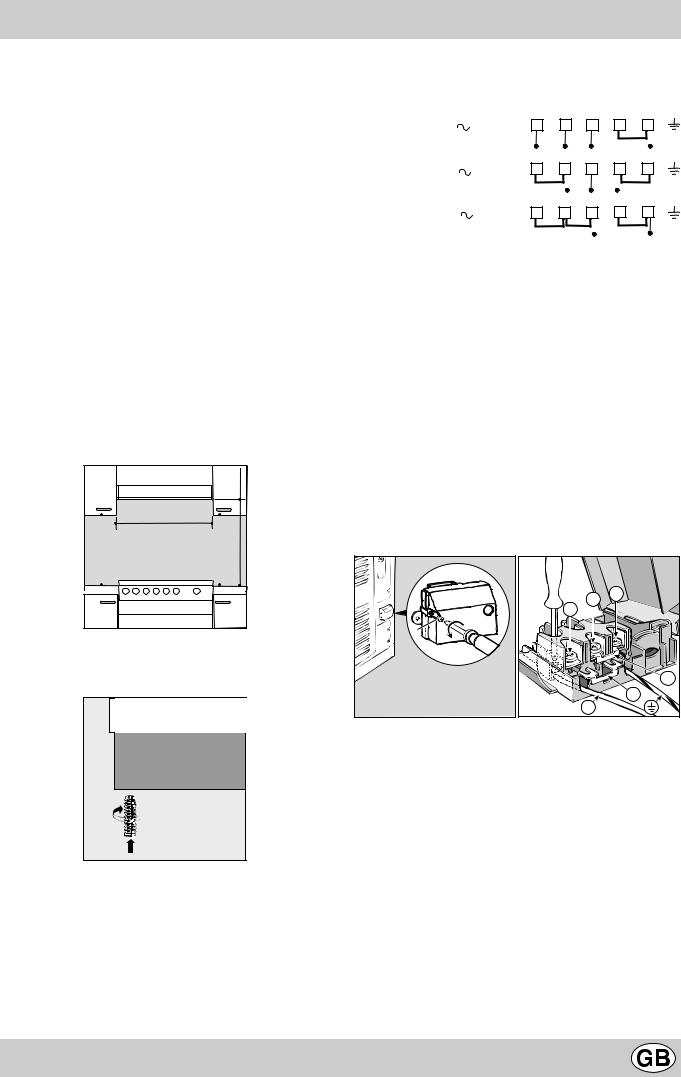
Installation
The following instructions should be read by a qualified technician to ensure that the appliance is installed, regulated and technically serviced correctly in compliance with current regulations.
Important: disconnect the cooker from the electricity when making any adjustement, maintenance operation, etc.
Positioning
The appliance can be installed next to furniture units which are no taller than the top of the cooker hob. For proper installation of the cooker, the following precautions must be taken:
a)Kitchen cabinets installed next to the cooker that are taller than the top of the hob must be situated at least 200 mm from the edge of the hob.
b)Hoods must be installed according to the requirements in the installation manual for the hoods themselves and in any case at a minimum distance of 650 mm.
c)Place the wall cabinets adjacent to the hood at a minimum height of 420 mm from the hob (see figure).
d)Should the cooker be installed beneath a wall cabinet, the latter should be situated at least 700 mm (millimetres) away from the hob, as shown in the figure.
e)the cut-out for the cooker cabinet should have the dimensions indicated in the figure.
HOOD
|
Min. 600 mm. |
min. 650 mm. with hood min. 700 mm. without hood |
Min. 420 mm. |
Min. 420 mm. |
Levelling
In order to have a perfect levelling of the cooker adjustable feets are supplyed. They can be screwed in the seats positioned in the corners of the cooker base.
Electrical connection
The power supply cable since its size depends on the electric connection (see the following connection diagram).
400 3N |
1 |
2 |
3 |
4 |
5 |
H05RR-F 5x2.5 CEI-UNEL 35363 |
R |
S |
T |
|
N |
400V 2N |
1 |
2 |
3 |
4 |
5 |
|
|
|
|
|
|
H05RR-F 4x2.5 CEI-UNEL 35363 |
|
R |
S N |
|
|
230V 1N |
1 |
2 |
3 |
4 |
5 |
H07RN-F 3x4 CEI-UNEL 35364 |
|
|
R |
|
N |
|
|
|
|
Feeding cable installation
Terminal block opening:
·Unscrew screw “V”
·Pull and open the junction block lid
For the installation of the feeding cable carry out the following operations:
· position the small connection A-B according to the type of connection that has to be performed using the scheme shown in the figure.
Note: the small connections are prepared by the Factory for the 230V monophase connection (contacts 1-2-3 are connected to one another). The bridge 4-5 is situated in the lower part of the terminal block.
·introduce the cables (N and 6) as shown in the figure and tighten the relative screws.
·fix the remaining cables on the 1-2-3 clips.
·fix the feeding cable in the special cable stop and close the cover fastening it with the screw “V”.
V |
2 |
3 |
1 |
|
|
B |
N |
A |
|
Connecting the supply cable to the mains
Fit a plug, normalised for the load indicated on the data plate, on the cable; when making the connection directly to the mains, an omnipoIar switch with a minimum opening of 3 mm between the contacts, must be installed between the appliance and the mains.This switch must be sufficient for the load and must comply to regulations in force (the earthing wire must not be interrupted by the switch). The power supply cable must be positioned so that it does not exceed 50°C more than room temperature at any point of its length. Before making the connection check that:
·the limiter valve and the home system can support the appliance load (see data plate);
·the power supply system has an efficient earthing connection which complies with the provisions of current regulations;
·the socket or omnipoar circuit-breaker is easily accessible once the cooker has been installed.
3
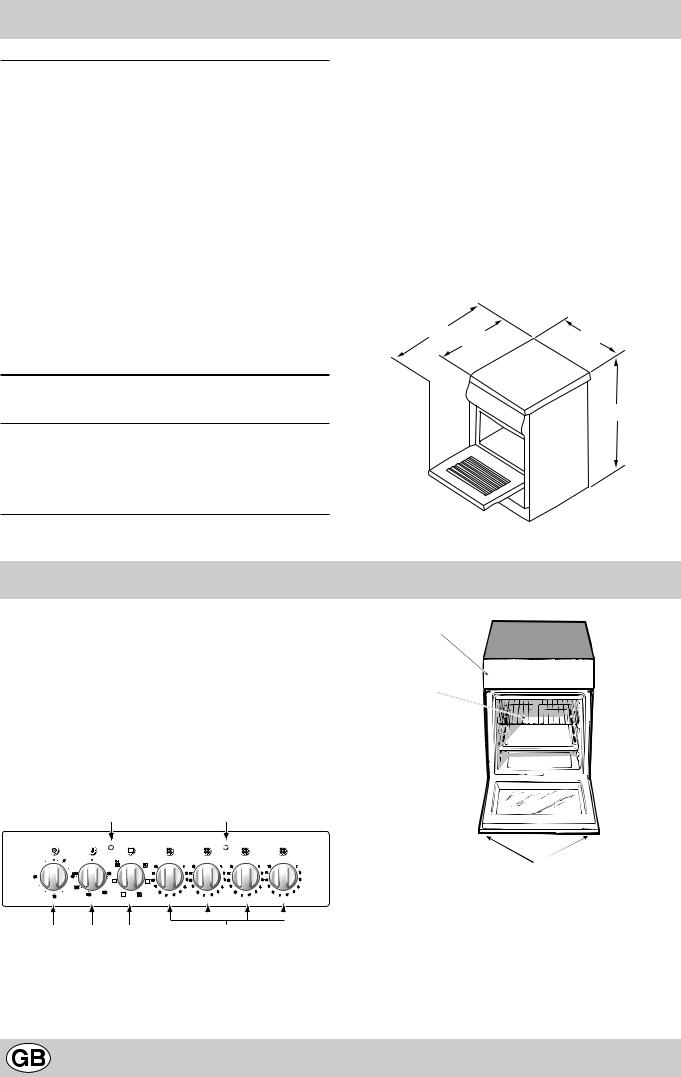
Technical Specifications
Oven |
|
Dimensions (WxDxH) |
39x41x34 cm |
Volume |
54 lt |
Oven absorption Max |
2100 W |
|
|
Ceramic Hob |
|
Front Left |
1200 W |
Back Left |
1800 W |
Back Right |
1200 W |
Front Right |
1800 W |
Hob Ceramic absorption Max |
6000 W |
|
|
ENERGY LABEL
Directive 2002/40/EC on the label of electric ovens Norm EN 50304
Energy consumption for Forced convection
heating mode: b Fan assisted Declared energy consumption for Natural convection Class
heating mode: a Convection
Voltage and frequency
230/400 V 3N~ 50/60 Hz
Inner Dimensions of the Food Warmer:
Width: 42 cm
Depth: 44 cm
Height: 23 cm
7
This appliance conforms with the following European Economic Community directives:
-73/23/EEC of 19/02/73 (Low Voltage) and subsequent modifications;
-89/336/EEC of 03/05/89 (Electromagnetic Compatibility) and subsequent modifications;
-93/68/EEC of 22/07/93 and subsequent modifications.
104 |
60 |
50 |
|
85/90
The cooker with electric oven and ceramic hob
D.Dripping Pan or Baking Sheet
E.Control Panel
F.Adjustable Feet or Legs
G.Selector Knob
H.The green pilot lamp
I.The control knobs for the electric plates
K.Oven Rack
L.Thermostat Light
M.Timer Knob
N.Thermostat Knob
L H
E
K
D
0 |
0 |
0 |
0 |
0 |
F
M N G I
4

How To Use Your Appliance
The various functions included in the cooker are selected by operating the control devices located on the cooker control panel.
Notice: The first time you use your appliance, we recommend that you set the thermostat to the highest setting and leave the oven on for about half an hour with nothing in it, with the oven door shut. Then, open the oven door and let the room air. The odour that is often detected during this initial use is due to the evaporation of substances used to protect the oven during storage and until it is installed.
Attention: Only use the bottom shelf of the oven when using the rotisserie to cook (where present). For all other types of cooking, never use the bottom shelf and never place anything on the bottom of the oven when it is in operation because this could damage the enamel. Always place your cookware (dishes, aluminium foil, etc. etc.) on the grate provided with the appliance inserted especially along the oven guides.
The Oven Control Knobs
The “5 Programms” oven combines all the advantages of traditional “static” ovens with those of modern “ventilated” ones.
The”5 Programms” oven is extremely versatile and offers 5 different but sure and easy ways of cooking. Use the knobs to select the different cooking functions available on the “5 Programms” oven:
G - selector knob; N - thermostat knob.
When the selector knob is on any other setting than that identified by the “o”, the oven light turns on. The setting
identified by the 8 symbol makes it possible to turn the oven light on without having any of the oven heating elements on. When the oven light is on, it means that the oven is in use, and it will remain on for the entire time the oven is being used.
1.Convection Mode
-Position of the “G” knob: a
-Position of the “N” knob: between 50°C and Max
On this setting, the light comes on and the top and bottom heating elements are activated. This is the classic, traditional type oven which has perfected, with exceptional heat distribution and reduced energy consumption. The convection oven is still unequalled when it comes to cooking dishes made up of several ingredients, e.g. cabbage with ribs, stews, etc. Excellent results are achieved when preparing meat-based dishes as well (braised meats, stew, goulash, wild game, ham etc.) which need to cook slowly and require basting or the addition of liquid. It still remains the best system for cooking pastries and fruit in general and when using specific covered containers for oven cooking.When cooking in convection mode, only use one drip- ping-pan or cooking rack at a time, otherwise the heat distribution will be uneven. Select from among the various rack heights based on whether the dish needs more or less heat from the top or bottom.
5
2. Ventilation Mode
-Position of the “G” knob: J
-Position of the “N” knob: between 50°C and Max
Since the heat remains constant and uniform throughout the oven due to the fan at the behind, the air cooks and browns food uniformly over its entire surface. With this mode, you can also cook various dishes at the same time, as long as their respective cooking temperatures are the same. A maximum of 2 rack levels can be used at the same time, following the instructions in the section entitled, “Cooking On More Than One Rack”. This cooking mode is ideal for au gratin dishes or those which require an extended cooking time like lasagne, macaroni bake, chicken and roast potatoes, etc...
Moreover, the excellent heat distribution makes it possible to use lower temperatures when cooking roasts. This results in less loss of juices, meat which is more tender and a decrease in the loss of weight for the roast. The ventilated mode is especially suited for cooking fish, which can be prepared with the addition of a limited amount of condiments, thus maintaining their flavour and appearance. Excellent results can also be attained when cooking vegetable like courgettes, aubergines, peppers, tomatoes, etc. Desserts: leavened cakes are also perfect for the ventilated mode. Moreover, this mode can also be used to thaw meat, fish and bread by setting the temperature to 80°- 100°C. To thaw more delicate foods, set the thermostat to 50°C or use only the cold air circulation feature by setting the thermostat to 0°C.
3. Grill
-Position of the “G” knob: I
-Position of the “N” knob: Max
The extremely high and direct temperature of the grill makes it possible to brown the surface of meats and roasts while locking in the juices to keep them tender. The grill is also highly recommended for dishes that require high temperature on the surface: beef steaks, veal, entrecôte, filets, hamburger etc...
4. The “Double Grill”
-Position of the “G” knob: d
-Position of the “N” knob: Max
This oversized grill has a completely new design, increasing cooking efficiency by 50%. The double grill also eliminates pockets of unheated air in the corners of the oven.
Important: Always leave the oven door closed when using the grill setting n order to achieve the best results and save on energy (about 10%).
When using the grill, place the rack at the top rack heights (see cooking table) and place the dripping-pan beneath the oven rack to prevent grease from falling onto the bottom of the oven.
5. Ventilated Double Grill
-Position of the “G” knob: K
-Position of the “N” knob: between 50 and 200°C
This combination of features increases the effectiveness of the unidirectional thermal radiation of the heating elements through forced air circulation of the air throughout the oven. This helps prevents foods from burning on the
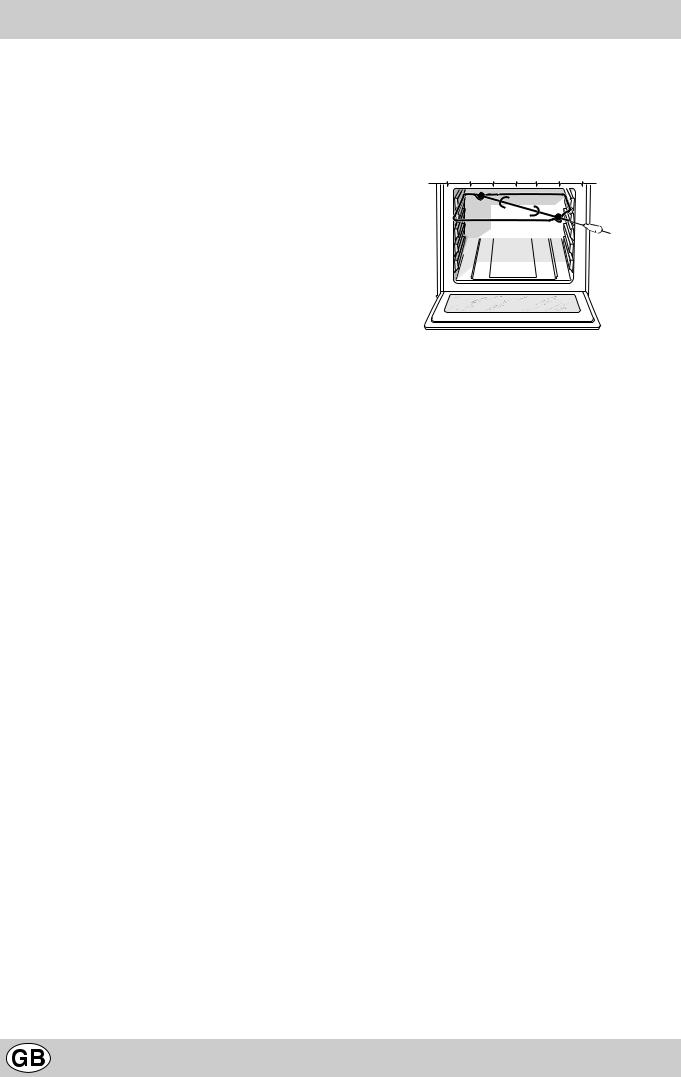
surface, allowing the heat to penetrate into the food. Excellent results are achieved with kebabs made with meats and vegetables, sausages, ribs, lamb chops, chicken, quail, pork chops, etc. This mode is also ideal for cooking fish steaks, like swordfish, tuna, grouper etc.
In this function, the rotisserie motor will also turn on (where present). Cooking with this function is especially recommended for meat dishes such as loins, poultry, etc….
Note: When using the grill (features 3, 4, 5), the oven door must be closed.
The oven-operating pilot lamp (L)
Signals when the oven is heating. It switches off when the temperature inside the oven reached the temperature selected by the knob. At this point the alternate turning on and turning off of this light indicates that the thermostat is operating correctly to keep the oven temperature constant.
Attention
Avoid the children touch the oven door because it is very hot during the cooking.
6
The rotisserie
To operate the rotisserie, proceed as follows:
a)place the dripping-pan on the 1st rack;
b)insertthespecialrotisseriesupportonthe4thrackandposition thespitbyinsertingitthroughthespecialholeintotherotisserie at the back of the oven;
c)to start the spit, set the oven selection knob (L) on setting x
Timer
To use the timer, it must be wound using the “M” knob. Turn the knob almost one full turn in the clockwise direction
4. Then, turn the knob back 5, and set the time by positioning the number (minutes) on the knob dial beneath the mark on the control panel.
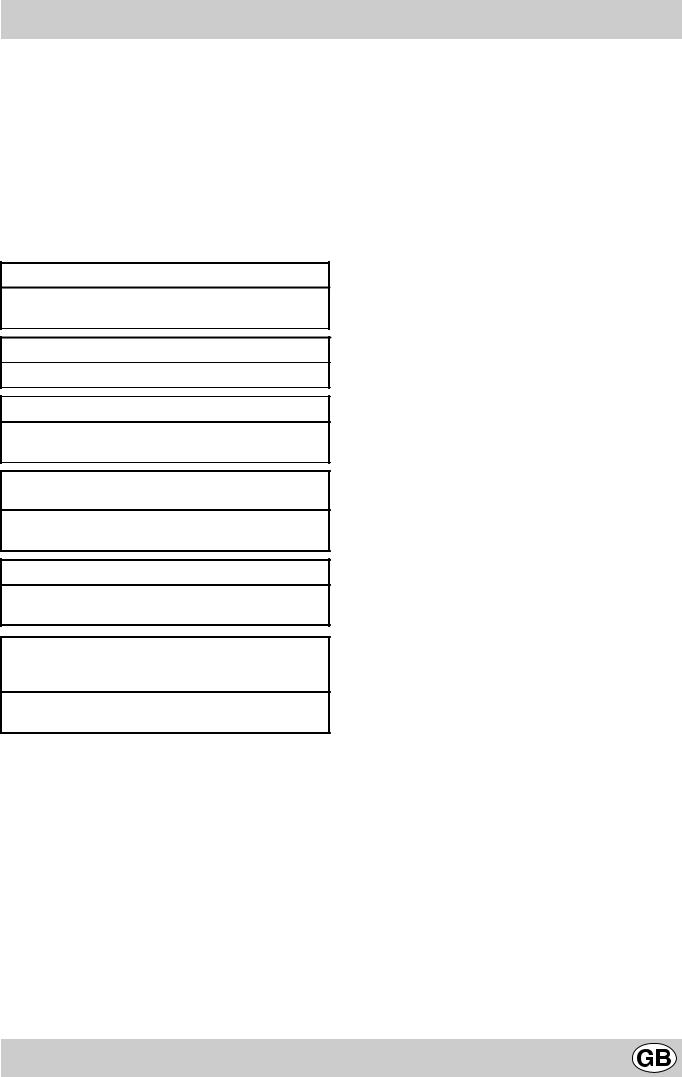
Practical Cooking Advice
The oven offers a wide range of alternatives which allow you to cook any type of food in the best possible way. With time you will learn to make the best use of this versatile cooking appliance and the following directions are only a guideline which may be varied according to your own personal experience.
Baking cakes
The oven should always be warm before putting in cakes wait till the end of preheating (about 10-15 min.).Cake-baking temperatures are normally around 160°C/200°C.Do not open the oven door during the baking process as this could cause the cake to sink.In general:
Pastry is too dry
Increase the temperature by 10°C and reduce the cooking time.
Pastry dropped
Use less liquid or lower the temperature by 10°C.
Pastry is too dark on top
Place it on a lower rack, lower the temperature, and increase the cooking time.
Cooked well on the inside but sticky on the outside
Use less liquid, lower the temperature, and increase the cooking time.
The pastry sticks to the pan
Grease the pan well and sprinkle it with a dusting of flour or use greaseproof paper.
I used more than one level (in the function "ventilated oven") and they are not all at the same cooking point
Use a lower temperature setting. It is not necessary to remove the food from all the racks at the same time.
Cooking fish and meat
When cooking white meat, fowl and fish use low temperatures. (150°C-175°C). When red meat must be superficially wellcooked but succulent inside, it is advisable to start with a high temperature (200-220°C) for a short time, and then to reduce it at a later point. Generally speaking, the more meat there is, the lower the temperature and the longer the cooking time should be.Place the meat in the centre of the grid and put a spill-tray underneath to catch grease drips. Insert the grid so that it is in the middle of the oven. If more heat from below is required, use the 1° bottom shelf.
Cooking on More Than One Rack
Should you need to use two grids, use only function 2 J “ventilated oven” which is the only solution for this process.
·The oven has 5 different rack heights.When cooking with the ventilated mode, use only the two centre rack heights:
the bottom and topmost rack heights directly receive hot air and this could result in more delicate dishes being burned.
·In general, use levels 2 and 4 from the bottom, placing the food requiring more heat at level no. 2. For example, when cooking a roast together with other food, place the roast at level 2 and the more delicate dishes at level 4.
·When cooking foods requiring different cooking times and temperatures, make sure that the temperature is set between the two recommended temperatures and put the more delicate dishes at level no. 4. Finally, remove the dish with the shorter cooking time first.
·Use the dripping pan at the bottommost rack height and the grill at the top.
·When cooking pizza on more than one rack with the temperature set at 220°C. Remember to preheat the oven for at least 15 minutes. In general the 4th rack height cooks a little slower, so remove the pizza on the second rack height first and leave the other one in the oven for a few minutes.
Using the Grill
The oven allows you to use two different grilling methods. Use the no. 3 setting I “Grill” for small portions. Energy consumption for this feature is only 1200 W; however, it is ideal for grilling small dishes or portions, e.g. toast, frankfurters, etc.
Place the food in the centre of the grill, as only the centre of the heating element is turned on. Food in the corners of the oven will not be cooked.
The no. 4 setting d“Double Grill” allows you to grill along the entire surface area of the grill itself. Use this feature when you have food distributed uniformly beneath the grill and you want it to be browned evenly.
Important: Always leave the oven door closed when using the grill setting n order to achieve the best results and save on energy (about 10%).
When using the grill settings, it is recommended that the thermostat be set to maximum, as this is the optimal setting for the grill, which utilizes radiation produced by infrared rays. However, this does not mean that lower temperature settings cannot be used when necessary by simply turning the control knob.
When using the grill, place the rack at the 4 rack heights (see cooking table) and place the dripping-pan beneath the oven rack to prevent grease from falling onto the bottom of the oven.
Setting 5 K“Ventilated Double Grill”, is extremely useful for grilling foods rapidly, as the distribution of heat makes it possible not only to brown the surface, but also to cook the bottom part. It can also be used to grill large pieces of meat or fowl. Moreover, it can also be used for browning foods at the end of the cooking process.
When using this function, place the grid on the 2nd or 3rd oven rack from the bottom (see cooking table) then, to prevent fat and grease from dripping onto the bottom of the oven and thus smoke from forming, place a dripping-pan on the 1st rack from the bottom. When using this function together with the spit (only on some models), you can also cook dishes on the dripping-pan situated on the 1st rack, for example: potatoes, etc…….
7
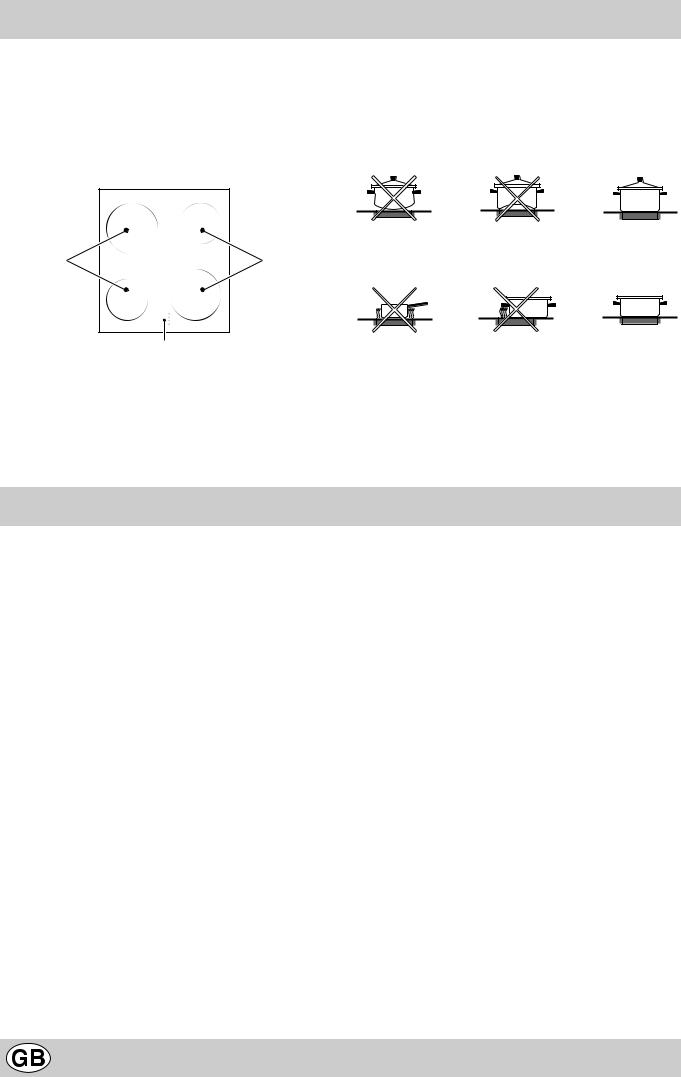
User’s instructions the ceramic hob
Description
The hobs have been provided with radiant electric heaters. These heaters are incorporated under the surface of the hob as zones which redden while they are in use.
A.Cooking area (A).
B.A lights which indicate whether the corresponding heaters are at a temperature in excess of 60° C; even if the hob/zone has been switched off.
Instructions for using the pyroceram top
To obtain the best results from your hob, there are some basic rules to follow when cooking or preparing food.
·All types of pots and pans may be used on the ceramic glass cooktop. However, the bottom surface must be perfectly flat. Naturally, the thicker the bottom of the pot or pan, the more uniformly the heat is distributed.
A |
A |
·Make sure that the base of the pan completely covers the cooking ring, so as to make full use of the heat produced
B
Description of the heating elements
The radiant heating elements are composed of circular heating elements.They only become red after being turned on for 10-20 seconds.
·Always make sure that the pan base is always dry and clean so as to guarantee proper contact as well as longer-lasting pans and the long life-span of the hob.
·Do not use the same pans which are used for cooking on gas burners. The heat strength of gas burners may deform the pan base and will not give the same results if it is subsequently used on a glazed ceramic hob.
Pratical advice for using the electric plates
Description of heating elements
Traditional radiant elements are composed of circular heating elements.They only become red after being turned on for 10-20 seconds.
·Control knobs for traditional cooking rings. Each ring is controlled by a knob which offers a choice of 12 different temperatures ranging from a minimum of 1 to a maximum of 12.
Set. |
Radiant Burner |
|
|
|
|
0 |
Off |
|
|
|
|
1 |
To melt butter and chocolate. |
|
|
|
|
2 |
To heat liquids. |
|
|
||
3 |
||
|
||
|
|
|
4 |
For creams and sauces. |
|
|
||
5 |
||
|
||
|
|
|
6 |
For cooking at the boiling point. |
|
|
||
7 |
||
|
||
|
|
|
8 |
For roasts. |
|
|
||
9 |
||
|
||
|
|
|
10 |
For boiling large pieces of meat. |
|
|
||
11 |
||
|
||
|
|
|
12 |
For frying. |
|
|
|
The green pilot lamp (H)
This lights up when an electric plate is turned on.
8

Practical Cooking Advice
Selection |
Food to be cooked |
Wt. |
Cooking |
Heating time |
Thermostat |
Cooking |
knob |
|
(Kg) |
position from |
(min.) |
knob |
time |
|
|
|
bottom |
|
|
(min.) |
|
|
|
|
|
|
|
1 Static |
Duck |
1 |
3 |
15 |
200 |
65-75 |
a |
Roast beef |
1 |
3 |
15 |
200 |
70-75 |
|
Roast pork |
1 |
3 |
15 |
200 |
70-80 |
|
Biscuits |
- |
3 |
15 |
180 |
15-20 |
|
Tarts |
1 |
3 |
15 |
180 |
30-35 |
|
|
|
|
|
|
|
2 Fan oven |
Pizza (on 2 racks) |
1 |
2-4 |
15 |
220 |
20-35 |
cooking |
Lasagne |
1 |
3 |
10 |
200 |
30-35 |
J |
Lamb |
1 |
2 |
10 |
180 |
50-60 |
|
Chicken + potatoes |
1 |
2-4 |
10 |
180 |
60-75 |
|
Mackerel |
1 |
2 |
10 |
180 |
50-55 |
|
Red porgy |
1.5 |
2 |
10 |
180 |
55-60 |
|
Plum cake |
1 |
2 |
10 |
170 |
40-50 |
|
Cream puffs (on 2 racks) |
0.5 |
2-4 |
10 |
190 |
25-35 |
|
Biscuits (on 2 racks) |
0.5 |
2-4 |
10 |
180 |
10-15 |
|
Sponge cake (on 1 |
0.5 |
3 |
10 |
165 |
25-30 |
|
rack) |
1.0 |
2-4 |
10 |
165 |
25-30 |
|
Sponge cake (on 2 |
|
|
|
|
|
|
racks) |
1.5 |
3 |
15 |
200 |
25-30 |
|
Savoury pies |
|
|
|
|
|
|
|
|
|
|
|
|
3 Grill |
Sole and cuttle fish |
1 |
4 |
5 |
Max |
8 |
I |
Squid and shrimp on |
1 |
4 |
5 |
Max |
4 |
|
spits |
|||||
|
Cod fillets |
1 |
4 |
5 |
Max |
10 |
|
Grilled vegetables |
1 |
3/4 |
5 |
Max |
8-10 |
|
|
|
|
|
|
|
4 Double Grill |
Veal steaks |
1 |
4 |
5 |
Max |
15-20 |
d |
Cutlets |
1.5 |
4 |
5 |
Max |
20 |
|
Hamburgers |
1 |
3 |
5 |
Max |
7 |
|
Caballas |
1 |
4 |
5 |
Max |
15-20 |
|
Toasted sandwiches |
n.° 4 |
4 |
5 |
Max |
5 |
|
|
|
|
|
|
|
5 Ventilated |
Grilled chicken |
1.5 |
2 |
5 |
200 |
55-60 |
Double Grill |
Cuttle fish |
1.5 |
2 |
5 |
200 |
30-35 |
K |
Chicken (inserted on |
1.5 |
- |
5 |
200 |
70-75 |
|
the spit) + potatoes (on |
|
|
|
|
|
|
the dripping-pan) |
- |
2 |
5 |
200 |
70-75 |
|
|
|
|
|
|
|
|
With rotisserie |
|
|
|
|
|
|
Veal on the spit |
1.5 |
- |
5 |
200 |
70-80 |
|
Chicken on the spit |
1.5 |
- |
5 |
200 |
70-80 |
|
Lamb on the spit |
1.5 |
- |
5 |
200 |
70-80 |
|
|
|
|
|
|
|
|
With multi-skewer |
|
|
|
|
|
|
rotisserie (only a few |
|
|
|
|
|
|
models) |
|
|
|
|
|
|
Meat kebabs |
1.0 |
- |
5 |
Max |
40-45 |
|
Vegetable kebabs |
0.8 |
- |
5 |
Max |
25-30 |
|
|
|
|
|
|
|
NB: cooking times are approximate and may vary according to personal taste.When cooking using the grill or double grill or ventilated double grill, the dripping-pan must always be placed on the 1st oven rack from the bottom.
9
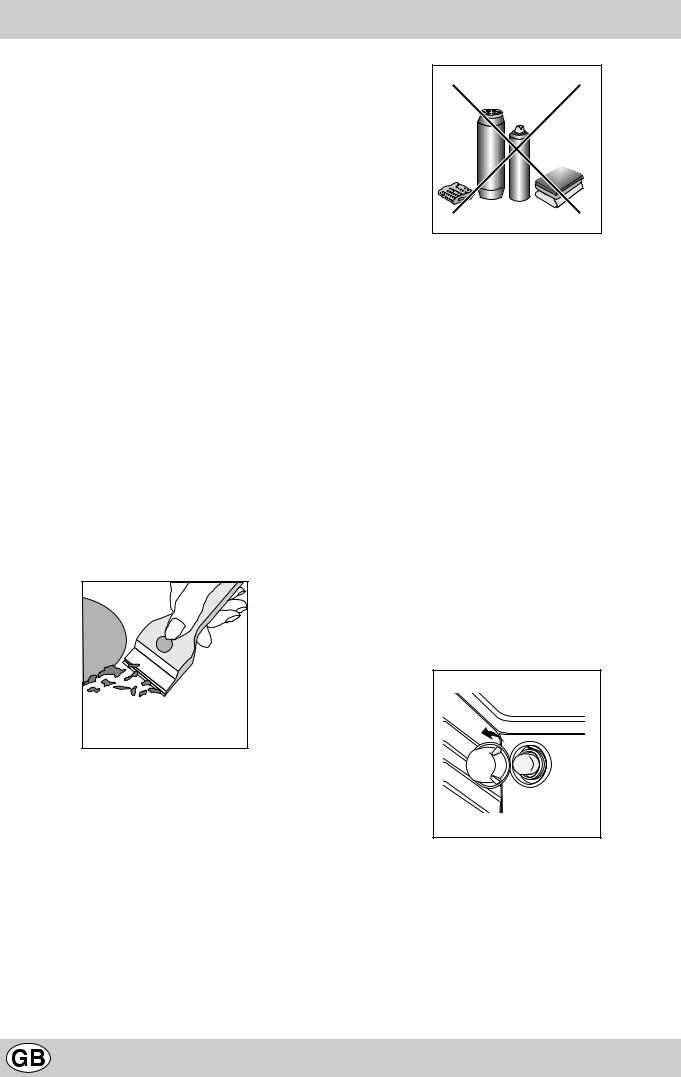
Routine maintenance and cleaning of the oven
Disconnect the oven from the source of electricity before performing any maintenance or cleaning. To ensure a long life for your oven, clean it frequently and carefully, keeping in mind that:
·Do not use steam equipment to clean the appliance.
·the enamelled parts and the self-cleaning panels should be washed with warm water without the addition of abrasive powders or corrosive substances which could damage the finish;
·The inside of the oven should be cleaned fairly often while it is still warm, using warm water and detergent followed by careful rinsing and drying;
·stainless steel may become marked if it comes into contact with very hard water or harsh detergents (containing phosphorous) for long periods of time. After cleaning, it is advisable to rinse thoroughly and dry. It is also recommended to dry any water drops;
·avoid dirt and grease accumulating on the control panel by cleaning it frequently. Use non-abrasive sponges or soft cloths to avoid scratching enamelled or shiny steel parts.
Cleaning the hob surface
Prior to cooking, the hob surface should always be cleaned using a damp cloth to remove any dust or stray food particles. The hob surface should be regularly cleaned with a lukewarm solution of water and a mild detergent. Periodically it may be necessary to use a proprietary ceramic hob cleaner. First remove all spilt food and fat with a window scrape, preferably the razor blade type B (not supplied) or, failing that, the fixed blade razor edge type.
Then clean the hob while it is still warm to the touch with a suitable cleaner and paper towel. Then rinse it and wipe it dry with a clean cloth .If aluminium foil or plastic items are accidentally allowed to melt on the hob surface they should be immediately removed from the hot cooking area with a scraper. This will avoid any possible damage to the surface. This also applies to sugar or any food with a high sugar content. Do not use abrasive sponges or scourers of any type. Corrosive cleaners such as oven sprays and stain removers should also not be used.
Glass ceramic hob |
Available from |
|
cleaners |
||
|
||
|
|
|
Window scraper Razor blade |
DIY Stores |
|
scrapers |
|
|
|
|
|
Replacement blades |
DIY Stores, |
|
|
supermarkets, |
|
|
chemists |
|
|
|
|
COLLO luneta |
Boots, Co-op stores, |
|
HOB BRITE |
department stores, Regional |
|
Hob Clean |
Electricity Company shops, |
|
SWISSCLEANER |
supermarkets |
|
|
|
Replacing the oven light bulb
·Either pull out the plug (if it is accessible) or disconnect the oven from the mains by turning off the multipole switch used for connecting the oven to the electricity source;
·Remove the glass cover of the lamp holder;
·Unscrew the bulb and replace it with a high temperature resistant bulb (300°C) with the following characteristics:
-Voltage 230/240 V
-Wattage 25W
-Type E14
·Replace the glass cover and reconnect the power supply to the oven.
10

Conseils
Pour garantir l’efficacité et la sécurité de ce produit:
•adressez-vous exclusivement à nos Services après-vente agréés
•exigez toujours l’utilisation de pièces détachées originales.
1Cet appareil a été conçu pour un usage familier,de type non professionnel.
2Ces instructions ne sont valables que pour les pays dont les symboles figurent dans la notice et sur la plaquette d’immatriculation de l’appareil.
3Ce mode d’emploi concerne un appareil classe 2 (libre pose) ou classe 2 - sous-classe 1 (encastré entre 2 meubles).
4Avant d’utiliser l’appareil, lisez attentivement cette notice car elle contient des instructions très importantes concernant la sécurité d’installation, d’usage et d’entretien.Conservez avec soin cette brochure pour toute consultation ultérieure.
5Après avoir déballé l’appareil, vérifiez s’il est intact. En cas de doute, et avant toute utilisation, consultez un technicien qualifié. Les éléments de l’emballage (sachets plastique, polystyrène expansé, clous, etc) ne doivent pas être laissés
àportée des enfants car ils pourraient être dangereux.
6L’installationdoitêtreeffectuéeconformémentauxinstructions du fabricant et par un professionnel qualifié. Le fabricant décline toute responsabilité pour tous dommages causés à des personnes, à des animaux ou à des choses du fait d’une installation incorrecte de l’appareil.
7La sécurité électrique de cet appareil n’est assurée que si ce dernier est correctement raccordé à une installation de mise
àla terre conformément aux normes de sécurité électrique. Il est indispensable de vérifier si cette condition fondamentale de sécurité est bien remplie;en cas de doute, faites appel
àun professionnel qualifié pour un contrôle minutieux de l’installation électrique. Le fabricant ne peut en aucun cas êtreconsidéréresponsabledesdommagespouvantsurvenir si l’installation de mise à la terre fait défaut.
8Avant de brancher l’appareil, vérifiez si les caractéristiques techniques reportées sur les étiquettes (apposées sur l’appareil et/ou sur l’emballage) correspondent bien à celles de votre installation électrique.
9Vérifiez si la charge électrique de l’installation et des prises de courant est apte à supporter la puissance maximum de l’appareil figurant sur la plaquette. En cas de doute, faites appel à un professionnel qualifié.
10Lors de l’installation, il faut prévoir un interrupteur omnipolaire ayant au moins 3 mm d’ouverture entre les contacts.
11En cas d’incompatibilité entre la prise et la fiche de l’appareil, remplacez cette prise par une autre appropriée et, pour ce faire, faites appel à un technicien qualifié qui devra également vérifier si la section des câbles de la prise est apte à supporter lapuissanceabsorbéeparl’appareil.Engénéral,ilvautmieux n’utiliser ni adaptateurs, ni prises multiples ni rallonges. Si leur emploi s’avère indispensable, n’utilisez que des adaptateurs simples ou multiples et des rallonges conformes aux normes de sécurité, tout en veillant à ne pas dépasser la limite de la charge électrique indiquée sur l’adaptateur simple ou sur les rallonges et la puissance max. indiquée sur l’adaptateur multiple.
12Ne laissez pas votre appareil branché inutilement.Eteignez l’interrupteur général de l’appareil quand vous ne l’utilisez pas.
13Les orifices ou les fentes d’aération ou d’évacuation de la chaleur ne doivent pas être bouchés.
14Le câble d’alimentation de cet appareil ne doit pas être remplacé par l’utilisateur. Si le câble est endommagé et doit être remplacé, adressez-vous à l’un des centres de service après-vente agréés par le fabricant.
15Cet appareil doit être destiné à l’usage pour lequel il a été conçu. Toute autre utilisation (comme par exemple le chauffage d’une pièce) est impropre et,en tant que telle, dangereuse.Le fabricant décline toute responsabilité en cas de dommages provoqués par un usage impropre ou erroné.
16L’usage de tout appareil électrique implique le respect de certaines règles fondamentales. A savoir:
•ne pas toucher l’appareil les pieds ou les mains mouillés ou humides
•ne jamais utiliser l’appareil pieds nus
•ne jamais utiliser de rallonges ou bien le faire avec un maximum de précautions
•nejamaistirersurlecordond’alimentationousurl’appareil pour débrancher la fiche de la prise de courant.
•ne pas exposer l’appareil aux agents atmosphériques (pluie, soleil, etc)
•ne pas laisser utiliser l’appareil, sans surveillance, par des enfants ou par des personnes incapables de le faire.
17Avant toute opération de nettoyage ou d’entretien, déconnectez l’appareil en débranchant la fiche ou en éteignant l’interrupteur de l’installation électrique.
18Si vous décidez de ne plus utiliser cet appareil, il est recommandé de le rendre inopérant en coupant le cordon d’alimentation,aprèsl’avoirdébranchédelaprisedecourant. Nous recommandons vivement de neutraliser les parties de l’appareilsusceptiblesdereprésenterundangerquelconque, surtout pour des enfants qui pourraient utiliser l’appareil pour jouer.
19Ne placez pas de casseroles instables ou déformées sur les brûleurs ou sur les plaques électriques pour éviter tout risque derenversement.Placez-lessurleplan decuisson,manches tournés vers l’intérieur, vous éviterez ainsi de les heurter par mégarde.
20N’utilisezjamaisdeliquidesinflammables(alcool,essence...) près de l’appareil quand vous êtes en train de l’utiliser.
21Si vous utilisez de petits électroménagers à proximité de la table, veillez à ce que leur cordon d’alimentation ne touche pas à des parties chaudes de l’appareil.
22Contrôlez toujours que les manettes soient bien dans la position “•”/“o” quand l’appareil n’est pas utilisé.
23En cours de fonctionnement, les éléments chauffants et certaines parties du four deviennent très chaudes.Attention à ne pas les toucher et à garder les enfants à distance.
24Si la cuisinière est installée sur un socle, prenez les précautions qui s’imposent pour que l’appareil ne tombe pas de ce socle.
11
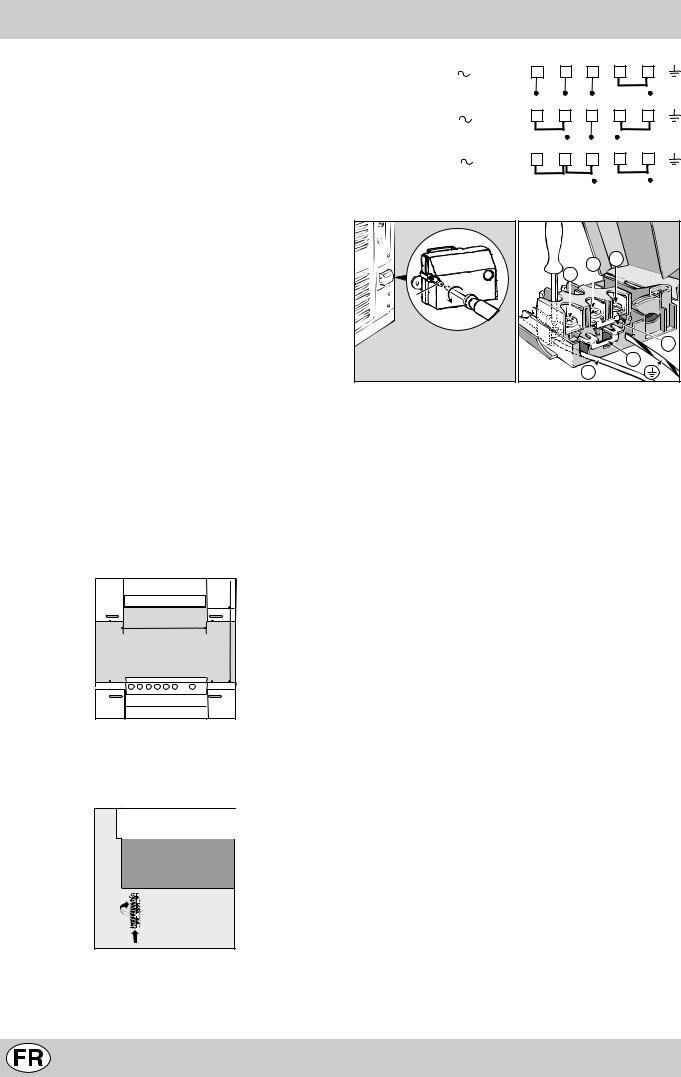
Installation
Les instructions suivantes s’adressent à l’installateur qualifié afin qu’il procède, correctement et suivant les normes en vigueur, aux opérations d’installation, de réglage et de maintenance technique.
Important: toute intervention de réglage, de maintenance etc. doit être effectuée après avoir débranché l’appareil.
Installation de la cuisinière
Possibilité d’installation côte à côte avec des meubles dont la hauteur ne dépasse pas celle du plan de travail. La paroi en contact avec la paroi postérieure de la cuisinière doit être réalisée en matériel non inflammable. Pendant le fonctionnement, la paroi postérieure de la cuisinière peut atteindre une température de 50°C supérieure à celle ambiante. Il faut observer les précautions suivantes pour une installation correcte de la cuisinière:
a)Installez cet appareil dans une cuisine, une salle à manger ou un studio, jamais dans une salle de bains.
b)Les meubles entourant l’appareil dont le plan de travail dépasse en hauteur le plan de la cuisinière doivent être placés à au moins 200 mm de distance de cette dernière. Ne placez pas de rideaux juste derrière la cuisinière ou sur les côtés, à moins de 200 mm.
c)Pour l’installation de hottes, suivez les instructions contenues dans leur mode d’installation.
d)Si la cuisinière est installée sous un élément suspendu, il faut que ce dernier soit placé à au moins 420 mm (millimètres) de distance du plan. Les meubles de cuisine inflammables installés juste au-dessus du plan de cuisson doivent être positionnés à au moins 700 mm de distance de ce dernier.
e)La paroi en contact avec la paroi postérieure de la cuisinière doit être réalisée en matériel non inflammable.
HOOD
|
Min. 600 mm. |
min. 650 mm. with hood min. 700 mm. without hood |
Min. 420 mm. |
Min. 420 mm. |
Nivellement (Il n’est présent que sur certains modèles) Des petits pieds de réglage sont fournis de manière à pouvoir niveler la cuisinière. Si nécessaire, ces petits pieds peuvent être vissés dans les logements adaptés prévus sur les angles à la base de la cuisinière.
Raccordement électrique
Le cordon doit être dimensionné en fonction du type de raccordement électrique utilisé (voir schéma de connexion sous indiqué).
400 3N |
1 |
2 |
3 |
4 |
5 |
H05RR-F 5x2.5 CEI-UNEL 35363 |
R |
S |
T |
|
N |
400V 2N |
1 |
2 |
3 |
4 |
5 |
|
|
|
|
|
|
H05RR-F 4x2.5 CEI-UNEL 35363 |
|
R |
S N |
|
|
230V 1N |
1 |
2 |
3 |
4 |
5 |
H07RN-F 3x4 CEI-UNEL 35364 |
|
|
R |
|
N |
|
|
|
|
Montage cordon d’alimentation
V |
2 |
3 |
1 |
|
|
B |
N |
A |
|
Fig. A |
Fig. B |
Ouverture du bornier: |
|
•Dévisser la vis “V” (Fig. A).
•tirer et ouvrir le couvercle du bornier.
Pour l’installation du cordon procédez comme suit:
•positionnez les barrettes de pontage A - B en fonction du type de raccordement que l’on veut obtenir en se
servant du schéma illustré figure B.
Note: les barrettes sont prévues en usine pour raccordement à 230V monophasé (contacts 1-2-3 raccordés entre eux). Le pont 4-5 est situé dans la partie inférieure du bornier.
•introduire les câbles ( N e 6) comme illustré par la figure et serrer les vis correspondantes.
•fixer les câbles restants sur les bornes 1-2-3.
•fixer le câble dans le serre-câble correspondant et fermer le couvercle en le fixant à l’aide de la vis “V”.
Raccordement du câble d’alimentation à la ligne
Monter sur le câble une fiche normalisée pour la charge indiquée sur la plaquette des caractéristiques, en cas de raccordement direct à la ligne il faut interposer entre l’appareil et la ligne un interrupteur omnipolaire avec une distance d’ouverture entre les contacts d’au moins 3 mm. dimensionné à la charge et conforme aux normes (le fil de terre, jaune-vert, ne doit pas être interrompu par l’interrupteur). Le câble d’alimentation doit être positionné de manière à n’atteindre en aucun point une température dépassant de 50°C la température ambiante.
Avant de procéder au raccordement, vérifiez si:
•la valve réductrice et l’installation domestique peuvent supporter la charge de l’appareil (voir plaquette des caractéristiques);
•l’installation d’alimentation dispose d’une mise à la terre efficace conformément aux normes et aux dispositions prévues par la loi;
•la prise ou l’interrupteur omnipolaire sont facilement accessibles après installation de l’appareil.
12
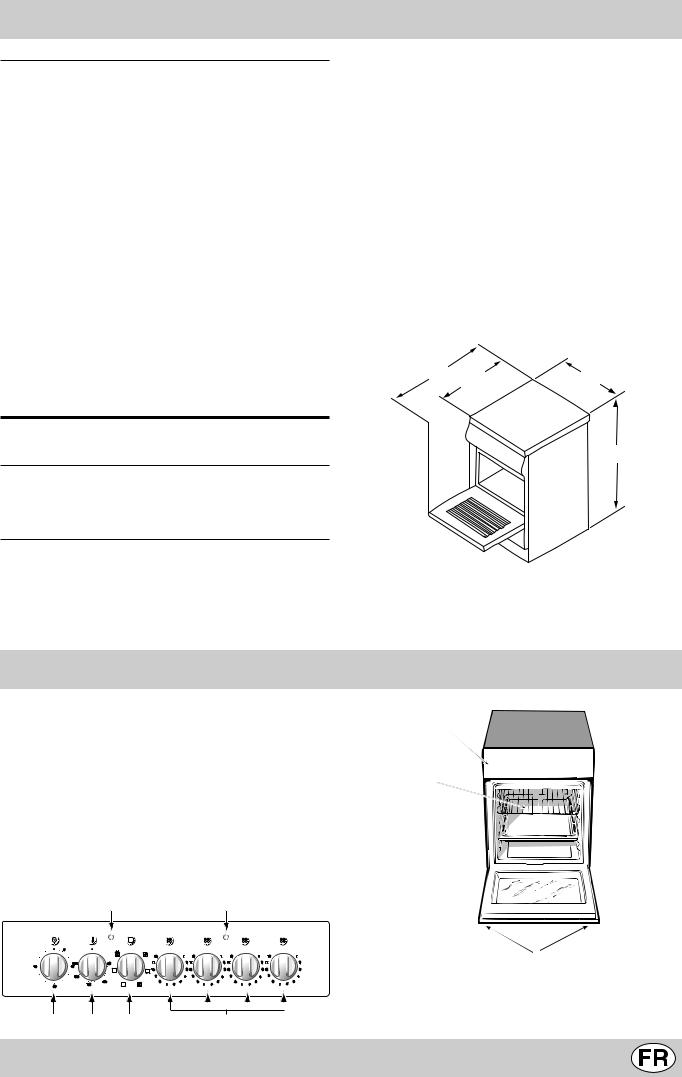
Caractéristiques Techniques
Four
Dimensions (HxLxP): 39x41x34 cm |
||
Volume: 54 Litres |
||
Absorption Max Four: 2100 W |
||
|
|
|
Plan de cuisson vitrocéramique |
|
|
Avant gauche |
1200 W |
|
Arrière gauche |
1800 W |
|
Arrière droit |
1200 W |
|
Avant droit |
1800 W |
|
Absorption Max plan de cuisson vitrocéramique |
6000 W |
|
|
|
|
ETIQUETTE ENERGIE
Directive 2002/40/CE sur l’étiquette des fours électriques
Norme EN 50304
Consommation énergie convection forcée
7
Cet appareil est conforme aux Directives Communautaires suivantes :
-73/23/CEE du 19/02/73 (Basse Tension) et modifications successives ;
-89/336/CEE du 03/05/89 (Compatibilité électromagnétique) et modifications successives ;
-93/68/CEE du 22/07/93 et modifications successives.
fonction four : b Ventilé Consommation énergie déclarée pour Classe convection naturelle
fonction four : a Statique
Voltage et Fréquence
230/400 V 3N~ 50/60 Hz
Dimensions utiles du tiroir chauffe-plats:
Largeur : cm 42 cm Profondeur : cm 44 cm Hauteur : cm 23 cm
104 |
60 |
50 |
|
85/90
La cuisinière avec four multifonction et table vitrocéramique
D.Lèche-frite ou plaque de cuisson
E.Tableau de bord
F.Pieds réglables
G.Manette de sélection
H.Voyant lumineux vert
I.Manette de la plaque électrique du plan de cuisson
K.Grille du four
L.Voyant lumineux thermostat
M.Minuterie
N.Manette du thermostat
E
K
D
L |
|
|
H |
|
0 |
0 |
0 |
0 |
0 |
F
M N G I
13
